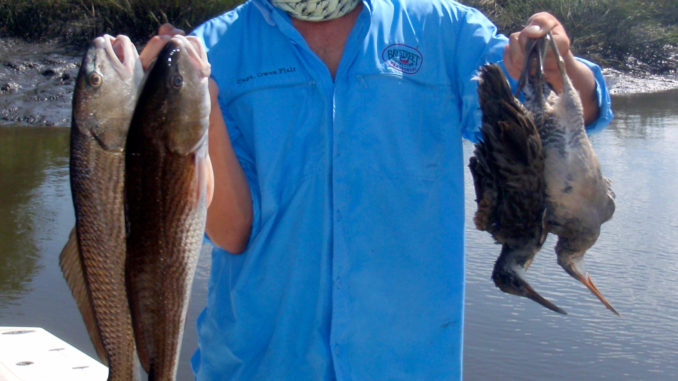
Cast-and-blast in the marsh? The Broad River tides will point you to marsh hens and redfish.
Being a sportsman in South Carolina is not an either/or situation. You can be a hunter or fisherman — or both. So it’s no surprise that Lowcountry sportsmen have discovered a way to combine their two loves on the Broad River, casting and blasting the day away.
Hunting for rails, known locally as marsh hens, opens at the same time that falling water temperatures really get redfish feeding in preparation for the coming winter.
“Reds and rails is the most-righteous way for an angler and hunter to enjoy the best of the Lowcountry,” said guide Owen Plair of Bay Street Outfitters in Beaufort.
Poling a shallow boat through the marsh on a big tide, South Carolina hunters enjoy a unique birding experience as rails flush from the flooded marsh, seeming to materialize from the spartina grass. Guide Tuck Scott, also of Bay Street Outfitters, likes really big tides for hunting marsh hens and generally hunts for approximately an hour-and-a-half before and after the top end of the tide.
“Tides vary in height based on location, but all those areas are relative to the tide anywhere else so we use the Southeastern Tide Log and look for a height at the Savannah River entrance of at least 8.7 feet,” Scott said.
ith years of experience hunting marsh hens, Tony Royal of Beaufort knows exactly why a big tide is best.
“The rail has long legs and will use them to escape danger if at all possible, and they will run on floating grass.” he said. “At higher tides, they have fewer places to run and are easier to flush.”
As the name implies, marsh hens are found in the marsh. One of the best ways for hunters to locate a good marsh is not with their eyes but rather with their ears.
“When fishing on the Broad, it is a good idea to have an open ear for crackling birds, and then go back to that area when hunting,” Scott said.
Once on a productive area of marsh, hunters look for specific features that attract marsh hens. Groups of birds can be found at the mouths of creeks, and any spots of high marsh that are not completely flooded are good places to locate birds, but floating clumps of dead marsh grass are often the most productive.
“These birds love to sit on top of the dead grass and blend in very well on top of these patches, but they will give themselves away by making their unique calls often when you get close to them,” Plair said.
The fishing part of the equation can take place before or after the bird hunting. Early in the rail season, if the weather is warm enough, tailing reds are still a possibility on the incoming tide. Scott likes to start searching for tailing reds in the grass about three hours before the top of the tide until the water gets high enough to go after marsh hens. He prefers casting flies to reds whenever possible.
“Sight-casting to these fish with a Dupree Spoon-Fly, a Redfish Toad, or a Fool’s Gold Crab is very effective,” he said.
Perhaps the best time to chunk some bait under a rattle cork is after the outgoing tide has dropped to a level that makes hunting rails impractical.
“Starting about an hour or so after the drop is when the fish really start biting on the Broad,” Plair said.
Seven-foot, medium-action spinning rods rigged with Cajun Thunder popping corks and live bait — mud minnows are popular — often produce the best results. If the water is a little stained, fresh cut mullet can help the reds find the bait. Good areas to target are creeks and ditches draining the marsh, especially if they have structure such as oyster beds nearby. Anglers also target areas of sparse grass against the marsh. Reds will hang in all of these areas trying to stay shallow enough to avoid becoming a porpoise’s dinner, moving out only as much as the receding tide forces them to. Patient anglers know that if the fishing is slow at the outset, it will eventually get better as the tide forces reds to bunch up into easily spotted schools.
Die-hards who prefer to stay on the water all day will also target reds around the low end of the tide. With a lack of other food sources readily available, porpoises, aka bottlenose dolphin, turn their attention to redfish, which is one of the main reasons the reds are schooled up on the flat. Fisherman cannot get too close to these fish; it requires a stealthy approach. An electric trolling motor is okay, but a carefully polled boat is even better. Cooler water temperatures mean clearer water, which not only makes it easier for anglers to spot fish, but spotting fisherman easier for reds. The most-successful anglers make relatively long casts with light lures or flies; this is not the time for popping corks and heavy leaders.
“I like to put the power pole down and wait on the fish to come to me,” said Steve Roll of Seas So Shallow Guide Service in Ladys Island. “That way, I don’t have to worry about getting too close and spooking them before I have a chance to make some casts to the school and hopefully catch several reds.”
Many sportsmen will alternate between hunting and fishing, spending one day in a deer stand or duck blind and another one fishing at the coast or in a rivers or lake. With marsh hen season comes the possibility for the South Carolina sportsman to be both a hunter and fisherman on the same outing, and the Broad River offers what may be the best opportunity for casting and blasting in the Palmetto State.
Drawing a bead on a marsh bird
Conditioned by years of hunting fast -moving birds on solid ground, many hunters have to adjust the way they home in on their targets when going after marsh hens.
“Leading the bird is rarely as challenging as quail or dove; one to three feet of lead is adequate if the hunter does not stop his swing,” said veteran hunter Tony Royal of Beaufort.
This makes it sound too easy, but a slow target offers challenges of its own. Many hunters will overcompensate and not lead the bird or not follow through with the shot, hesitating like they have just swung their gun on a stationary target.
“Misses are obvious because the pattern is visible on the water,” said Royal, who has had the opportunity to hunt marsh hens with many hunters new to the sport. “I have seen many good shots miss these slow birds three and four feet behind. It is really a good learning experience and teaches us the importance of maintaining a sustained lead and following through.”
Marsh hens will often not flush until the boat is relatively close, so a more sporting gauge is often used, down to as small as a .410.
“We like small gauge shotguns like 20, 28, and .410,” he said. “Small gauges make the sport a little more of a challenge; I personally use a side-by-side 28 gauge.”
Another consideration when choosing what gun to use is price.
“You want to make sure you do not use a very high-class shotgun due to the fact it will be exposed to salty air and possibly spray,” Plair said.
A good cleaning and oiling after every outing is a requirement for any shotgun used to hunt marsh hens.
Hunting may require adjustments both during and after, but it also allows hunters to experience a different kind of bird hunting.
Wanton waste
An oft-repeated recipe for marsh hens is to pay someone to clean the birds and then pay the same someone to eat them.
Because of marsh hen’s reputation of being less-than-palatable, sportsman have sometimes exhibited less than sportsman-like behavior, returning empty-handed after a successful day hunting.
The S.C. Department of Natural Resources has a term for disposing of gamebirds — wanton waste, which is illegal. Rails are considered migratory game birds in South Carolina and fall under those regulations. A person convicted of wanton waste in a state court can be fined up to $500 fine and receive30 days in jail. A conviction of wanton waste in a federal court can result in a $15,000 fine and a year in jail. Any plan for hunting marsh hens should also include a plan for the harvest after the hunt is over.
Many recipes can be found online for marsh hen, but most have a few things in common. Birds should be skinned and not plucked, because their skin is tough and unpalatable. Overnight brining in salty water with a little vinegar will eliminate the “fishy” taste.
Fried, smothered in gravy and served over rice is usually the recommended preparation. That sounds pretty darn good, and according to many of the old folks living in the Lowcountry it is exceptional.
Anyone claiming that marsh hens are not worth eating probably has never had them prepared correctly.
DESTINATION INFORMATION
WHERE/WHEN TO GO — Redfish can be caught from mouth of the Broad River upstream to the burnt railroad trestle on the Jasper/Beaufort County line, and most any of the marshes along the river hold marsh hens. The season on marsh hens runs from Oct. 22 and ends Dec. 24. Rails can be hunted from 30 minutes before sunrise until sunset. Redfish are caught year-round on the river.
GEAR — For redfish, 7-foot medium-action spinning outfits with reels spooled with braided lines are ideal. On outgoing tides, float a live or artificial bait under a popping cork. Live or artificial baits rigged with little to no weight are best for tailing reds in the grass and schooling reds on low tide. Fly-fishermen should use 7- to 8-weight rods with floating fly lines. When hunting for marsh hens, many hunters shoot smaller-gauge shotguns: 20-, 28- and .410s are popular. Non-toxic shot is required. A net with a long handle is needed to scoop up the fallen birds.
GUIDES/INFO — Capt. Tuck Scott, Capt. Owen Plair, Bay Street Outfitters, 843-524-5250,
www.baystreetoutfitters.com; Beaufort Boat and Dock Supply, 843-986-0552.
ACCOMMODATIONS — Beaufort Visitor and Convention Bureau,
800-638-3525,
www.beaufortsc.org.
MAPS — Capt. Segull’s Nautical Charts, 888-473-4855, www.captainsegullcharts.com; Top Spot waterproof map N233, is available from local tackle shops.

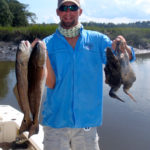
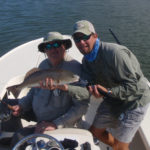
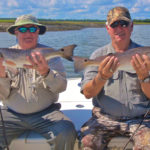
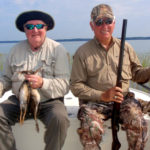
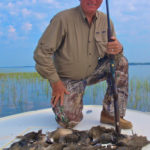
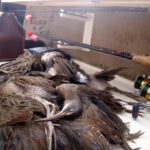



Be the first to comment